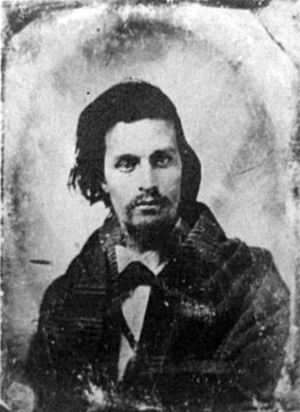Richard Realf facts for kids
Richard Realf (born June 14, 1832, in Framfield, England – died October 28, 1878, in Oakland, California) was a poet who traveled a lot across the United States. His experiences in these different places often inspired his writing.
Contents
Early Life and First Poems
Richard Realf started writing poems when he was just fifteen years old. Two years later, he worked as a secretary for a lady in Brighton.
A speaker who gave talks about how people's minds work (called phrenology) once read some of Realf's poems. He used them to show how creative young Realf was. Because of this, several important writers in Brighton noticed him and encouraged his talent.
With their help, a collection of his poems was published in London in 1852. It was called "Guesses at the Beautiful." After this, Realf spent a year in Leicestershire, studying how to farm scientifically. In 1854, he moved to the United States.
Adventures in the United States
After arriving in the U.S., Richard Realf explored the busy neighborhoods of New York City. He became a helper in the Five Points area, which was a tough part of the city. He helped set up affordable lectures and a group for people to improve themselves.
Joining the Fight for Freedom
In 1856, Realf went to Kansas with a group of people who wanted Kansas to be a "free state." This meant they wanted to stop slavery from spreading there. In Kansas, he became a journalist and wrote for several newspapers.
He met John Brown, a famous leader who fought against slavery. Realf even went with John Brown to Chatham, Ontario, Canada. Brown had a plan for a new government, and Realf was supposed to be its Secretary of State.
However, Brown's plan was put on hold for two years. During this time, Realf visited England and traveled through the Southern states of the U.S. When John Brown made his attack on Harpers Ferry in October 1859, Realf was in Texas. He was arrested and sent to Washington, D.C., facing danger on his journey.
Serving in the Civil War
In early 1862, Realf joined the 88th Illinois Volunteer Infantry Regiment and fought in the American Civil War. He wrote some of his best poems while he was serving in the army, and these poems became very popular.
After the war, he became an officer in the United States Colored Troops. These were regiments of African American soldiers, and at that time, their officers were all white. In 1866, he left the army with the rank of Captain and was recognized as a Lieutenant-Colonel. In June 1865, he married Sophia Emery Graves in Valparaiso, Indiana.
Life After the War
In 1868, Richard Realf started a school for freedmen in South Carolina. Freedmen were people who had been enslaved but were now free. A year later, he became an assessor for the government in the Edgefield area.
He left this job in 1870 and moved back North. He became a journalist and speaker, living in Pittsburgh, Pennsylvania. From 1870 to 1876, he wrote for the Pittsburgh Commercial newspaper.
Richard Realf was known as a brilliant speaker. He gave lectures like "Battle-Flashes" and "The Unwritten Story of the Martyr of Harpers Ferry." He also wrote poems for important groups like the Society of the Army of the Cumberland in 1873 and the Society of the Army of the Potomac in 1874. Some of his most famous poems include "My Slain," "An Old Man's Idyll," and "Indirection."
Images for kids



